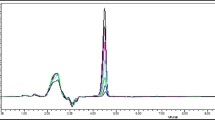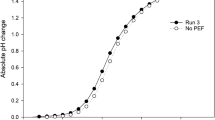Abstract
Purpose
The presence of residues of veterinary drugs in animal-derived food is one of the major problems for food safety. The consumption of milk containing antibiotic residues can evoke allergic reactions in hypersensitive individuals, disorders of intestinal flora and produces the risk of emerging antibiotic resistance microorganism.
Methods
In this study, the effect of the thermal treatments and pulsed electric field (PEF) on the reduction of benzylpenicillin (PNG) spiked artificially in milk was evaluated quantitatively by calculating the loss of the concentration using HPLC. Fresh raw milk was subjected to a high-temperature short-time (72 °C for 15 s, HTST), low-temperature long- time (62.5 °C for 30 min, LTLT) and ultrahigh-temperature processing (138 °C for 2 s, UHT). The PEF process factors output voltage (20–65%) and pulse width (10–26 μs) were optimized for maximum reduction of PNG by employing the statistical tool response surface methodology (RSM).
Results
HTST, LTLT, and UHT have resulted in the reduction of PNG 13.5%, 6.1%, 1.2% respectively. The optimized parameters of the PEF treatment had reduction efficiency in the range of 79–86%. The saddle response surface obtained from RSM showed that the center was neither at maximum point nor at the minimum point. The predicted and experimental values of the response were nearly similar which proved the suitability of the fitted quadratic model. Combined thermal and PEF treatment has a significant synergistic effect in reducing the PNG.
Conclusions
PEF induced reduction efficiency achieved was 79–86%. The reduction percentages were observed higher in the combined pasteurization and PEF treatment of milk. The pulsed electric field can be adopted as a unique processing tool for degradation of antibiotic residues whilst retaining nutritional quality parameters.





Similar content being viewed by others
Data availability
Not applicable.
References
Han RW, Zheng N, Yu ZN, Wang J, Xu XM, Qu XY, et al. Simultaneous determination of 38 veterinary antibiotic residues in raw milk by UPLC–MS/MS. Food Chem. 2015;181:119–26.
Kukusamude C, Santalad A, Boonchiangma S, Burakham R, Srijaranai S, Chailapakul O. Mixed micelle-cloud point extraction for the analysis of penicillin residues in bovine milk by high performance liquid chromatography. Talanta. 2010;81:486–92.
Aldeek F, Canzani D, Standland M, Crosswhite MR, Hammack W, Gerard G, et al. Identification of penicillin G metabolites under various environmental conditions using UHPLC-MS/MS. J Agri Food Chem. 2016;64:6100–7.
Sachi S, Ferdous J, Sikder MH, Hussani SAK. Antibiotic residues in milk: past, present, and future. J Adv Veterinary Animal Res. 2019;6:315–32.
Nisha AR. Antibiotic residues-a global health hazard. Veterinary World. 2008;1:375.
Grunwald L, Petz M. Food processing effects on residues: penicillin’s in milk and yoghurt. Anal Chim Acta. 2003;483:73–9.
Kantiani L, Farre M, Barcelo D. Analytical methodologies for the detection of β-lactam antibiotics in milk and feed samples. TrAC Trends Anal Chem. 2009;28:729–44.
Codex Alimentarius Commission (2015). Maximum residue limits (MRLS) and risk management recommendations (RMRS) for residues of veterinary drugs in foods CX/MRL2–2018.
European Commission. Commission regulation (EU) no 37/2010 of 22 December 2009 on pharmacologically active substances and their classification regarding maximum residue limits in foodstuffs of animal origin. Off J Eur Union. 2010;15:1–72.
Heshmati A. Impact of cooking procedures on antibacterial drug residues in foods: a review. J Food Quality Hazards Control. 2015;2:33–7.
Cabizza R, Rubattu N, Salis S, Pes M, Comunian R, Paba A, et al. Impact of a thermisation treatment on oxytetracycline spiked ovine milk: fate of the molecule and technological implications. LWT-Food Sci and Tech. 2018;96:236–43.
Shaltout FAE, Shatter MAE, Sayed NF. Impacts of different types of cooking and freezing on antibiotic residues in chicken meat. J Food Sci Nutri. 2019;5:45.
Roca M, Villegas L, Kortabitarte ML, Althaus RL, Molina MP. Effect of heat treatments on stability of β-lactams in milk. J of Dairy Sci. 2011;94:1155–64.
Chu L, Zhuang S, Wang J. Degradation kinetics and mechanism of penicillin G in aqueous matrices by ionizing radiation. Radiat Phys Chem. 2018;145:34–8.
Magureanu M, Piroi D, Mandache NB, David V, Medvedovici A, Bradu C, et al. Degradation of antibiotics in water by non-thermal plasma treatment. Water Res. 2011;45:3407–16.
Arslan-Alaton I, Caglayan AE. Toxicity and biodegradability assessment of raw and ozonated procaine penicillin G formulation effluent. Ecotoxicol Environ Safety. 2006;63:131–40.
Su S, Guo W, Yi C, Leng Y, Ma Z. Degradation of amoxicillin in aqueous solution using sulphate radicals under ultrasound irradiation. Ultrasonics Sonochem. 2012;19:469–74.
Toepfl S, Heinz V, Knorr D Applications of pulsed electric field technology for the food industry: In: Pulsed Electric Field Treatment of Foods, editors: Raso J. und Heinz, V, Springer, Boston, MA; 2006. pp. 197–221.
Kumar R, Bawa AS, Kathiravan T, Nadanasabapathi S. Optimization of pulsed electric field parameters for mango nectar processing using response surface methodology. Intern Food Res J. 2015;22:1353–60.
Vijayalakshmi S, Nadanasabhapathi S, Kumar R, Kumar S. Effect of pH and pulsed electric field process parameters on the aflatoxin reduction in model system using response surface methodology. J Food Sci Tech. 2018;55:868–78.
Zhang Y, Hou Y, Zhang Y, Chen J, Chen F, Liao X, et al. Reduction of diazinon and dimethoate in apple juice by pulsed electric field treatment. J Sci Food Agri. 2012;92:743–50.
Chen F, Zeng L, Zhang Y, Liao X, Ge Y, Hu X, et al. Degradation behaviour of methamidophos and chlorpyrifos in apple juice treated with pulsed electric fields. Food Chem. 2009;112:956–61.
Delsart C, Grimi N, Boussetta N, Miot Sertier C, Ghidossi R, Vorobiev E, et al. Impact of pulsed electric field and high voltage electrical discharges on red wine microbial stabilization and quality characteristics. J Appl Microbiol. 2016;120:152–64.
Junza A, Amatya R, Barrón D, Barbosa J. Comparative study of the LC–MS/MS and UPLC–MS/MS for the multi-residue analysis of quinolones, penicillins and cephalosporins in cow milk, and validation according to the regulation 2002/657/EC. 2011. J Chromatography B. 2011;879:2601–10.
Barbosa-Canovas GV, Yildiz S, Oner ME, Candogan K. Selected novel food processing technologies used as hurdles. In: Demirci A, Feng H, Krishnamurthy K, editors. Food Safety Engineering. Food Engineering Series. Cham: Springer; 2020. p. 629–57.
Sepulveda DR, Gongora-Nieto MM, Guerrero JA, Barbosa-Cánovas GV. Production of extended-shelf life milk by processing pasteurized milk with pulsed electric fields. J Food Eng. 2005;67:81–6.
Canton L, Alvarez L, Canton C, Ceballos L, Farias C, Lanusse C, et al. Effect of cooking on the stability of veterinary drug residues in chicken eggs. Food Additives Contaminants: Part A. 2019;36:1055–67.
Zorraquino MA, Roca M, Fernandez N, Molina MP. Althaus R heat inactivation of β-lactam antibiotics in milk. J Food Protection. 2008;71:1193–8.
Hsieh MK, Shyu CL, Liao JW, Franje CA, Huang YJ, Chang SK, et al. Correlation analysis of heat stability of veterinary antibiotics by structural degradation, changes in antimicrobial activity and genotoxicity. Veterinarni Medicina. 2011;56:274–85.
Deshpande AD, Baheti KG, Chatterjee NR. Degradation of β-lactam antibiotics. Curr Sci. 2004;87:1684–95.
Tian L, Khalil S, Bayen S. Effect of thermal treatments on the degradation of antibiotic residues in food. Critical Rev Food Sci Nutr. 2017;57:3760–70.
Chavoshan S, Khodadadi M, Nasseh N. Photocatalytic degradation of penicillin G from simulated wastewater using the UV/ZnO process: isotherm and kinetic study. J Environ Health Sci Eng. 2020;18:1–11.
Norzaee S, Taghavi M, Djahed B, Mostafapour FK. Degradation of penicillin G by heat activated persulfate in aqueous solution. J Environ Manag. 2018;215:316–23.
Misra NN. The contribution of non-thermal and advanced oxidation technologies towards dissipation of pesticide residues. Trends Food Sci Tech. 2015;45:229–44.
Sarangapani C, O'Toole G, Cullen PJ, Bourke P. Atmospheric cold plasma dissipation efficiency of agrochemicals on blueberries. Innov Food Sci Emerg Tech. 2017;44:235–41.
Zhang Y, Sun J, Hu X, Liao X. Spectral alteration and degradation of cyanidin-3-glucoside exposed to pulsed electric field. J Agri Food Chem. 2010. 58; 6:3524–3531.
Acknowledgements
Shinde Gokul Pandharinath would like to greatly acknowledge Defence Research and Development Organization (DRDO) for awarding Senior Research Fellowship (SRF). The authors also express deep gratitude to The Director, Defence Food Research Laboratory, Mysore, India for his constant support and encouragement.
Author information
Authors and Affiliations
Corresponding authors
Ethics declarations
Consent to participate
Not applicable.
Ethics approval
Authors declare compliance with ethical standard.
Consent for publication
Authors permission to publish relevant contributions.
Conflict of interest
The authors declare that no conflict of interest exists.
Additional information
Publisher’s note
Springer Nature remains neutral with regard to jurisdictional claims in published maps and institutional affiliations.
Rights and permissions
About this article
Cite this article
Shinde, G.P., Kumar, R., Reddy, K. et al. Impact of pulsed electric field processing on reduction of benzylpenicillin residue in milk. J Environ Health Sci Engineer 19, 1143–1151 (2021). https://doi.org/10.1007/s40201-021-00680-3
Received:
Accepted:
Published:
Issue Date:
DOI: https://doi.org/10.1007/s40201-021-00680-3




